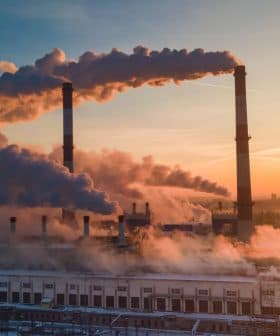Greenhouse Gases at Record Levels, WMO Reports
Greenhouse gases in the atmosphere continue to climb and are not showing signs of slowing, according to a report by the World Meteorological Organization.
The World Meteorological Organization’s latest Greenhouse Gas Bulletin shows that levels of carbon dioxide, methane, and nitrous oxide in the atmosphere are at record highs, posing a threat to the environment. Without immediate reductions in these gases, climate change will continue to cause irreversible and destructive impacts on life on Earth, according to the WMO’s secretary general.
The World Meteorological Organization’s (WMO) latest Greenhouse Gas Bulletin reveals that greenhouse gases in the atmosphere continue to rise and have reached a record high.
Without rapid cuts in CO2 and other greenhouse gases, climate change will have increasingly destructive and irreversible impacts on life on Earth.
The levels of carbon dioxide (CO2), methane and nitrous oxide are now far above pre-industrial levels. Unfortunately, this upward trend is not showing signs of reversal and global temperatures are rising as a result.
See Also:Olive Oil Production Gives Back to Environment More than it Takes
“The science is clear. Without rapid cuts in CO2 and other greenhouse gases, climate change will have increasingly destructive and irreversible impacts on life on Earth. The window of opportunity for action is almost closed,” warned Petteri Taalas, the WMO’s secretary general in a November 20 press release. “The last time the Earth experienced a comparable concentration of CO2 was 3 to 5 million years ago when the temperature was 2 – 3°C warmer and sea level was 10 – 20 meters higher than now,” added Taalas.
The WMO Greenhouse Gas Bulletin reports on the concentration of greenhouse gases in the atmosphere, i.e. the concentration of gases which remain in the atmosphere after about half is absorbed by the ocean and the biosphere (one quarter each).
The authors of this UN agency report are meteorology experts and researchers whose conclusions are based on observations of the WMO Global Atmosphere Watch Programme which monitors and analyses greenhouse gases on the basis of data received from 53 countries.
The report reveals that in 2017, levels of carbon dioxide, the main greenhouse gas in the atmosphere, reached a global average of 405.5 parts per million, 146 percent of the pre-industrial era. Forty percent of the methane absorbed into the atmosphere comes from natural sources, while 60 percent is man-made and the result of cattle farming, rice cultivation, fossil fuels, landfills and biomass burning.
As for the level of methane in the atmosphere, this was at 1,859 parts per billion in 2017, and at 257 percent of the pre-industrial level.
Nitrous oxide is another greenhouse gas produced by both natural (60 percent) and man-made (40 percent) elements like the use of fertilizers, industrial processes and the burning of biomass. In 2017, the concentration of this gas in the atmosphere was 329.9 parts per billion, 122 percent of pre-industrial levels.
These three greenhouse gases trap heat in the atmosphere, a phenomenon that’s leading to climate change, rising sea levels, extreme weather patterns and ocean acidification — a decrease in the pH of the ocean due to increased CO2 in the atmosphere. The rising levels of greenhouse gases are attributed to industrialization, the use of fossil fuels, intensive farming and deforestation.
The report also reveals that an illegal chemical called CFC-11, banned in 1987 under the Montreal Protocol, is still in use. This chlorofluorocarbon is also a greenhouse gas that destroys the stratospheric ozone layer. In the past decade its use has fallen, but since 2012 this decline has slowed down by two thirds due to the continuing production of CFC-11 in China and specifically its polyurethane foam industry.
The WMO’s bulletin follows the report by the Intergovernmental Panel on Climate Change (IPCC) published in October. “Global Warming of 1.5 °C” examined the impacts of global warming and warned that net human-caused CO2 emissions must reach zero by 2050 to minimize temperature increases to below 1.5°C. The 2016 Paris Agreement on climate change set the goal to limit a rise in world temperatures to below 2 degrees Celsius (3.6 degrees Fahrenheit) by 2030.
Both of these important reports have the scope to inform decision-making during the upcoming UN Climate Change Conference due to be held in Katowice, Poland from 2 – 14 December 2018.
Research has found that the production of olive oil, using the right farming techniques, can contribute significantly to reducing greenhouse gas emissions.
- Greenhouse gas levels in atmosphere reach new record (WMO)
- The State of Greenhouse Gases in the Atmosphere Based on Global Observations through 2017
- Net CO2 storage in Mediterranean olive and peach groves









